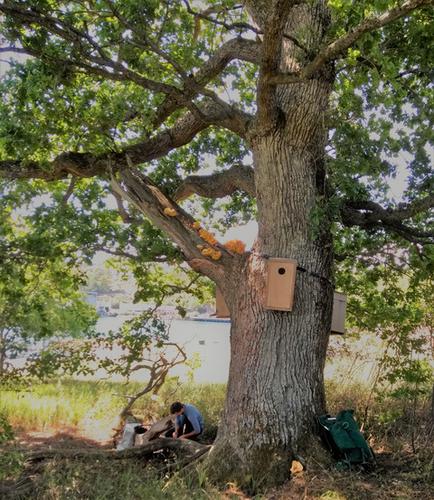当前位置:
X-MOL 学术
›
Funct. Ecol.
›
论文详情
Our official English website, www.x-mol.net, welcomes your feedback! (Note: you will need to create a separate account there.)
It takes a community to maintain a tree hollow: Food web complexity enhances decomposition and wood mould production
Functional Ecology ( IF 5.2 ) Pub Date : 2022-07-19 , DOI: 10.1111/1365-2435.14146 Ross Wetherbee 1 , Tone Birkemoe 1 , Johan Asplund 1 , Marek Renčo 2 , Anne Sverdrup‐Thygeson 1
Functional Ecology ( IF 5.2 ) Pub Date : 2022-07-19 , DOI: 10.1111/1365-2435.14146 Ross Wetherbee 1 , Tone Birkemoe 1 , Johan Asplund 1 , Marek Renčo 2 , Anne Sverdrup‐Thygeson 1
Affiliation

|
Veteran trees are keystone structures and play vital roles in ecosystems. Tree hollows, which are filled with a mix of leaves and wood that is transformed by the biotic community into wood mould, represent an important microhabitat. Tree hollow communities consist of three major groups of organisms: microbes, mesofauna (nematodes, mites and springtails) and macrofauna (beetles, millipedes and other insects). Little is known about the interplay between associated biota and their importance for decomposition and wood mould production. The aim of this study was to test how initial food web complexity in artificial tree hollows influences community structure, decomposition, and wood mould production. We used large wooden boxes to imitate natural hollows, and mounted them on 20 veteran oaks in Southern Norway. The food webs were manipulated into three levels: (i) a complex community with macrofauna and mesofauna, (ii) a simple community without macrofauna, and (iii) only the defaunated material. Three boxes (one of each treatment, N = 60 boxes) were mounted on each oak and left in the field from May 2017 to October 2019 (28 months). After the field experiment, macrofauna and mesofauna were collected and identified, mass loss in the boxes was determined, and nitrogen and phosphorus concentrations in the wood mould were measured. We found that the complex community treatment had the greatest diversity of beetles and the highest number of predatory macrofauna. The nematodes within the complex community treatment had greater trophic structuring with K-selected species associated with stable conditions. The nematodes communities also indicated that the complex community had a balanced decomposition pathway, while the simple community was dominated by fungi and the defaunated community by bacteria. Lastly, we found that the boxes with the complex community treatment had the highest overall rate of mass loss, and greater amounts of wood mould with higher concentrations of nitrogen and phosphorus. Our results indicate that macrofauna in artificial hollows increase trophic structuring, enhance decomposition rates and wood mould production, and mediate the decomposition pathway. These findings highlight the importance of food web complexity for promoting biodiversity and ecosystem functioning in veteran tree hollows.
中文翻译:

需要一个社区来维护一个树洞:食物网的复杂性增强了分解和木模的产生
老树是基石结构,在生态系统中发挥着至关重要的作用。树洞里充满了树叶和木材的混合物,这些树叶和木材被生物群落转化为木霉,代表了一个重要的微生境。树空心群落由三大类生物组成:微生物、中型动物(线虫、螨虫和跳虫)和大型动物(甲虫、千足虫和其他昆虫)。关于相关生物群及其对分解和木霉生产的重要性之间的相互作用知之甚少。本研究的目的是测试人造树洞中初始食物网的复杂性如何影响群落结构、分解和木霉生产。我们使用大木箱来模仿天然空心,并将它们安装在挪威南部的 20 棵老橡树上。食物网被分为三个层次:(i)具有大型动物和中型动物的复杂群落,(ii)没有大型动物的简单群落,以及(iii)只有动物区系的材料。2017 年 5 月至 2019 年 10 月(28 个月),将三个盒子(每种处理一个,N = 60 盒子)安装在每棵橡树上并留在田间。田间试验后,收集并鉴定大型动物和中型动物,测定箱内质量损失,测定木模中的氮和磷浓度。我们发现复杂的群落处理具有最大的甲虫多样性和最多的捕食性大型动物。复杂群落处理中的线虫具有更大的营养结构,其中 K 选择的物种与稳定的条件相关。线虫群落也表明复杂群落具有平衡的分解途径,而简单群落以真菌为主,而非动物群落以细菌为主。最后,我们发现具有复杂群落处理的盒子的总体质量损失率最高,并且具有更高浓度的氮和磷的木霉数量更多。我们的研究结果表明,人工空洞中的大型动物增加了营养结构,提高了分解速率和木模生产,并调节了分解途径。这些发现强调了食物网复杂性对于促进老树洞中生物多样性和生态系统功能的重要性。而简单的群落以真菌为主,而非动物群落则以细菌为主。最后,我们发现具有复杂群落处理的盒子的总体质量损失率最高,并且具有更高浓度的氮和磷的木霉数量更多。我们的研究结果表明,人工空洞中的大型动物增加了营养结构,提高了分解速率和木模生产,并调节了分解途径。这些发现强调了食物网复杂性对于促进老树洞中生物多样性和生态系统功能的重要性。而简单的群落以真菌为主,而非动物群落则以细菌为主。最后,我们发现具有复杂群落处理的盒子的总体质量损失率最高,并且具有更高浓度的氮和磷的木霉数量更多。我们的研究结果表明,人工空洞中的大型动物增加了营养结构,提高了分解速率和木模生产,并调节了分解途径。这些发现强调了食物网复杂性对于促进老树洞中生物多样性和生态系统功能的重要性。我们的研究结果表明,人工空洞中的大型动物增加了营养结构,提高了分解速率和木模生产,并调节了分解途径。这些发现强调了食物网复杂性对于促进老树洞中生物多样性和生态系统功能的重要性。我们的研究结果表明,人工空洞中的大型动物增加了营养结构,提高了分解速率和木模生产,并调节了分解途径。这些发现强调了食物网复杂性对于促进老树洞中生物多样性和生态系统功能的重要性。
更新日期:2022-07-19
中文翻译:

需要一个社区来维护一个树洞:食物网的复杂性增强了分解和木模的产生
老树是基石结构,在生态系统中发挥着至关重要的作用。树洞里充满了树叶和木材的混合物,这些树叶和木材被生物群落转化为木霉,代表了一个重要的微生境。树空心群落由三大类生物组成:微生物、中型动物(线虫、螨虫和跳虫)和大型动物(甲虫、千足虫和其他昆虫)。关于相关生物群及其对分解和木霉生产的重要性之间的相互作用知之甚少。本研究的目的是测试人造树洞中初始食物网的复杂性如何影响群落结构、分解和木霉生产。我们使用大木箱来模仿天然空心,并将它们安装在挪威南部的 20 棵老橡树上。食物网被分为三个层次:(i)具有大型动物和中型动物的复杂群落,(ii)没有大型动物的简单群落,以及(iii)只有动物区系的材料。2017 年 5 月至 2019 年 10 月(28 个月),将三个盒子(每种处理一个,N = 60 盒子)安装在每棵橡树上并留在田间。田间试验后,收集并鉴定大型动物和中型动物,测定箱内质量损失,测定木模中的氮和磷浓度。我们发现复杂的群落处理具有最大的甲虫多样性和最多的捕食性大型动物。复杂群落处理中的线虫具有更大的营养结构,其中 K 选择的物种与稳定的条件相关。线虫群落也表明复杂群落具有平衡的分解途径,而简单群落以真菌为主,而非动物群落以细菌为主。最后,我们发现具有复杂群落处理的盒子的总体质量损失率最高,并且具有更高浓度的氮和磷的木霉数量更多。我们的研究结果表明,人工空洞中的大型动物增加了营养结构,提高了分解速率和木模生产,并调节了分解途径。这些发现强调了食物网复杂性对于促进老树洞中生物多样性和生态系统功能的重要性。而简单的群落以真菌为主,而非动物群落则以细菌为主。最后,我们发现具有复杂群落处理的盒子的总体质量损失率最高,并且具有更高浓度的氮和磷的木霉数量更多。我们的研究结果表明,人工空洞中的大型动物增加了营养结构,提高了分解速率和木模生产,并调节了分解途径。这些发现强调了食物网复杂性对于促进老树洞中生物多样性和生态系统功能的重要性。而简单的群落以真菌为主,而非动物群落则以细菌为主。最后,我们发现具有复杂群落处理的盒子的总体质量损失率最高,并且具有更高浓度的氮和磷的木霉数量更多。我们的研究结果表明,人工空洞中的大型动物增加了营养结构,提高了分解速率和木模生产,并调节了分解途径。这些发现强调了食物网复杂性对于促进老树洞中生物多样性和生态系统功能的重要性。我们的研究结果表明,人工空洞中的大型动物增加了营养结构,提高了分解速率和木模生产,并调节了分解途径。这些发现强调了食物网复杂性对于促进老树洞中生物多样性和生态系统功能的重要性。我们的研究结果表明,人工空洞中的大型动物增加了营养结构,提高了分解速率和木模生产,并调节了分解途径。这些发现强调了食物网复杂性对于促进老树洞中生物多样性和生态系统功能的重要性。



























 京公网安备 11010802027423号
京公网安备 11010802027423号